Lou Gehrig: The Yankees Iron Horse and First Official Legend
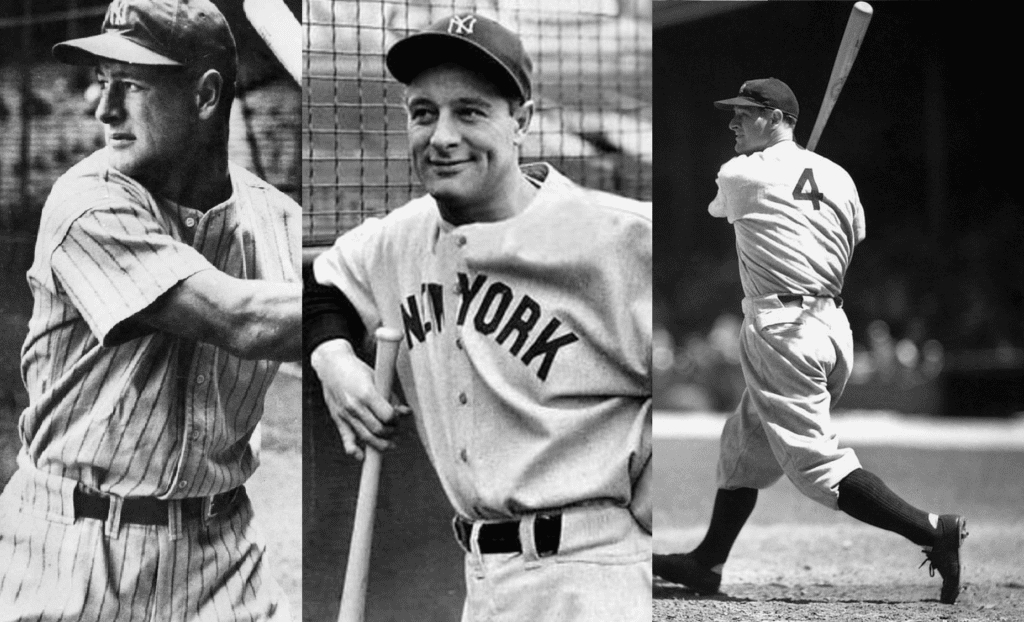
John Allen
More Stories By John Allen
- Mother’s Day: How Anthony Volpe’s mom molded him into a Yankee phenom
- Yankees submit offer to Juan Soto amid free agency, leave Torres without qualifying bid
- Yankees’ 40-man roster leaves out Soto, Verdugo, Torres, bullpen arms, adds three from MiLB
- Yankees secure Gerrit Cole for now, pushing extension discussion to a future date
- Once a powerhouse, former Yankee Joey Gallo eyes free agency after Nationals decline option
Table of Contents
| Position | First Baseman |
| Active years | 1923-1939 |
| MLB Teams (years) | New York Yankees (1923-1939) |
| Debut | June 15, 1923 (vs. St. Louis Browns) |
| Last game | April 30, 1939 (vs. Washington Senators) |
| Date of Birth | June 19, 1903 |
| Native place | New York |
| Batted | Left |
| Threw | Left |
| All-Star | ×7 (1933–1939) |
| World Champions | ×6 (1927, 1928, 1932, 1936–1938) |
| AL MVP | ×2 (1927, 1936) |
| Number retired | New York Yankees No. 4 |
| Hall of Fame year | 1939 (Voted by Special Election) |
| MLB Awards | Triple Crown (1934) AL batting champion (1934) 3× AL home run leader (1931, 1934, 1936) 5× AL RBI leader (1927, 1928, 1930, 1931, 1934) Hit 4 home runs in one game on June 3, 1932 |
| Legacy | Monument Park honoree Major League Baseball All-Century Team Major League Baseball All-Time Team |
| Nickname | The Iron Horse, Biscuit Pants, Buster, Laruppin’, Crown Prince of Swat or Columbia |
The Break-out Chance
On June 2, 1925, Wally Pipp, the Yankees’ first baseman and two-time AL home run leader, had a headache. Miller Huggins, the manager of the Yankees, replaced him with Henry Louis Gehrig or Lou Gehrig. The 21-year-old pinch hitter had been with the Yankees since 1923 and took over first base right away. On that day, Lou Gehrig hit the ball crazy and Huggins decided to keep Gehrig on his team for good forgetting Wally Pipp, one of their best power hitters. Lou Gehrig went on to play for the Yankees for 2,130 games in a row until he retired in 1939 forced by a fatal medical condition.
Lou Gehrig wore uniform number 4 because he batted after Babe Ruth, who was the Yankees’ third batter. The steady Yankee first baseman soon emerged as the best “ballplayer” in the game. He was one of the best hitters and run producers in the Yankees’ baseball history. Gehrig had 13 straight seasons where he scored more than 100 runs and had at least 100 RBI though he played regularly for 14 seasons only. He was the American League leader four times in runs, three times in home runs, five times in RBI, five times in on-base percentage, and once in batting average. Seven times, Lou Gehrig’s batting average was among the top three in the league and he had eight seasons with 200 or more hits.
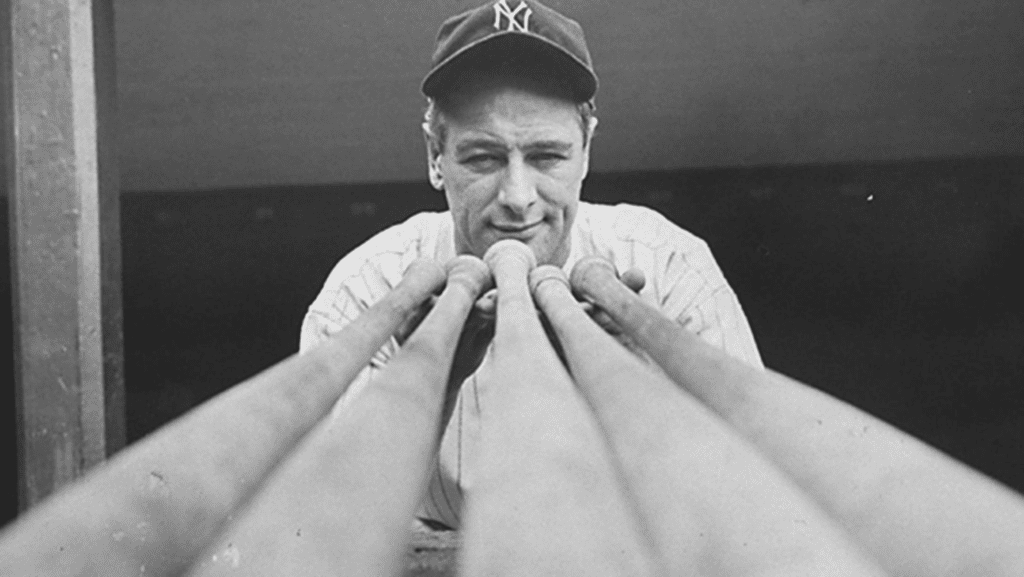
In 1931, Lou Gehrig set the AL record for most RBIs in a single season with 185. He was second only to Babe Ruth, who drove in 162. In 1934, when he won the Triple Crown, he hit .363, 49 home runs, and 166 runs. From 1933 to 1939, Lou Gehrig played first base for the first seven All-Star teams. He retired just before the 1939 game. In his 17 years as a Yankees player, the team won seven pennants and six World Series. Lou Gehrig contributed to the World Series by hitting .361, 10 home runs, and 35 RBI in 34 games. He would have set more records hadn’t he been forced to retire at the age of 36 because of amyotrophic lateral sclerosis.
The Bio
On June 19, 1903, Lou Gehrig was born to German immigrants in the Yorkville neighborhood of Manhattan. Dad Heinrich was often unemployed because he was an alcoholic and had seizures, but mom Christina worked as a maid. Gehrig helped his mother with work when he was very young. He did things like folding laundry and getting supplies from stores. He didn’t learn English until he was five years old.
The Gehrig family moved from Yorkville to Washington Heights when Lou was five years old. The American League’s New York Highlanders were then playing at Hilltop Park, which was close to their new apartment. The Polo Grounds, where the New York Giants of the National League play, was not too far. It is the most beautiful sports stadium in the world then. Living close to these parks made Lou Gehrig interested in baseball at a young age. When he started playing with the other kids in his neighborhood, he quickly found out that he was better than most of them. Soon, he was known as one of the best kids’ baseball players in the city.
Lou Gehrig liked the Giants when he was a kid, and he went to games at the Polo Grounds whenever he had 25 cents to get a left-field bleacher seat. Lou’s parents were not too happy about their son’s new interest in baseball, which Christina Gehrig said was just a game for kids. After all, she was a first-generation immigrant who worked hard but was poor and had few chances for a better life. But that chance could come for her son. Christina wanted her son to be “in business” one day, so she thought Lou Gehrig should focus on his schoolwork and not waste time in baseball. Lou did what his mother told him to do for a while and worked hard on his schoolwork in elementary school, where he was a better-than-average student. During his childhood and teen years, Lou Gehrig still found time to play baseball on weekends and during the summers.
In 1917, Lou Gehrig went to Manhattan’s Commerce High School, where he became a star in both baseball and football. On June 26, 1920, the city of Chicago hosted a baseball game between the New York City high school champions, Gehrig’s Commerce team, and the Windy City champions, Chicago’s Lane Tech High School. This was the first time Lou Gehrig got national attention for his baseball skills. At Cubs Park (later Wrigley Field), where the game took place, more than 10,000 people watched him.
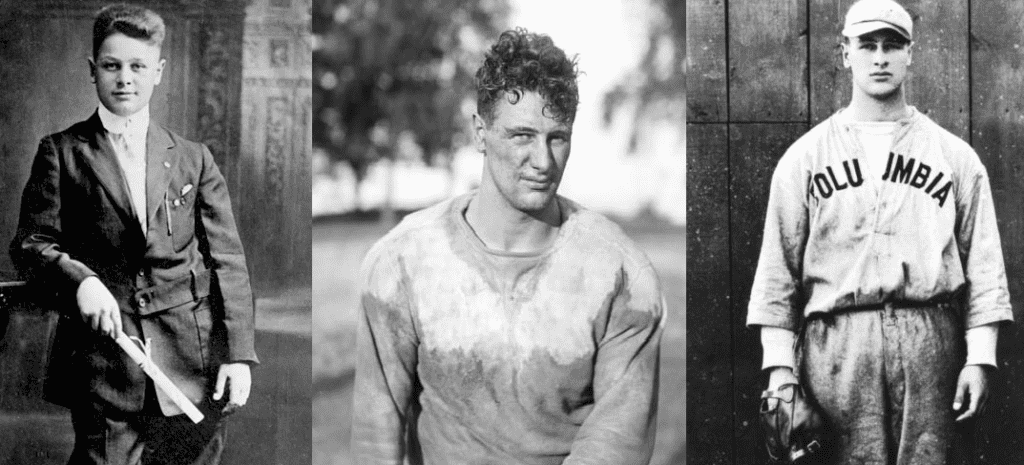
Commerce was ahead 8-6 in the top of the ninth inning when 17-year-old Lou Gehrig came up to bat with the bases full. Lou Gehrig hit the first pitch over the wall in the right field and out of sight. It was a grand slam, and it was a huge one. The next day, an article in the sports section of the Chicago Tribune said, “Gehrig’s blow would have made any big leaguer proud, but it was hit by a boy who hasn’t even started shaving yet.”
The New York Daily News said that “Babe” Gehrig was the bright star of the inter-city game. It might have been the first time sportswriters compared Lou Gehrig to Babe Ruth, but it wouldn’t be the last.
Lou Gehrig’s actions at the game in Chicago made him well-known in his hometown. Before he even put on a college uniform, Arthur Irwin, a scout for the Giants, approached him at Columbia University and asked if he’d like a tryout. Arthur Irwin, the scout, told Lou that manager John McGraw had seen him play, liked what he did, and wanted to sign the 18-year-old to a contract.
Because of these perks and the fact that his parents needed money, Lou Gehrig went to a tryout at the Polo Grounds in June 1921. When Gehrig hit six home runs in a row during batting practice, everyone on the field, including manager John McGraw, took notice. Gehrig let the first ground ball hit his way and roll through his legs, which wasn’t a good fielding move. Arthur Irwin told Lou that he could help him get a contract to play baseball for the rest of the 1921 season with the Class A Eastern League’s Hartford Senators. Lou Gehrig played 12 games for the Hartford team under the names “Lefty Gehrig” and “Lou Lewis.”
Lou Gehrig was banned from college baseball for a year because he broke the rules by playing professional baseball while he was still on the Columbian line. In 1923, Gehrig’s second year of college baseball, he finally got to play. When he did, Lou Gehrig set the college baseball world on fire. Lou broke school records for batting average (.444), slugging percentage (.937), and home runs in a 19-game season (seven). His skill at the plate quickly became legendary.

Lou Gehrig was also the best pitcher on the team. His best game on the mound was against Williams College on April 18, 1923, the same day that Yankee Stadium opened. Gehrig got 17 batters to strike out, which is still a school record. The big left-hander also pitched in 11 of the team’s 19 games and had a 6-4 record and 77 strikeouts.
On April 26, 1923, eight days later, Paul Krichell attended the Columbia vs Rutgers game. He was so impressed by Lou Gehrig’s performance against Rutgers that the Yankees scout immediately called the Yankees’ general manager, Ed Barrow, and told him that he had just found another Babe Ruth.
In his next game, which was against NYU, Lou Gehrig went 2-for-3 and hit a huge home run. Krichell went up to Gehrig after the game and set up a meeting for the next morning between Lou and the Yankees’ general manager, Ed Barrow. Barrow gave Lou a contract that paid him a $1,500 bonus and $400 a month. For the poor Gehrig family, this was a real windfall. Lou Gehrig took the job because he was glad to be able to make money and wasn’t too upset about leaving college, where he hadn’t made many friends. So, Lou Gehrig became a New York Yankee after signing the contract.
The Yankees thought that the young slugger was ready for the big leagues in 1923, but sent Lou Gehrig to minors after seven games. Lou Gehrig did very well there. In only 59 games, he hit .304 and 24 home runs. In September, the Yankees brought him back. Lou Gehrig hit .476, a home run, and eight RBIs in six more games. Huggins wanted to add Gehrig to the team for the World Series against the cross-town Giants because he had been hitting well in the last few games. Huggins’ request to Commissioner Kenesaw Mountain Landis, on the other hand, was turned down, mostly because Giants manager John McGraw objected. This was the same manager who turned down Lou Gehrig just two years before. Even though Gehrig wasn’t added to the postseason team, it didn’t matter in the end because the Yankees won the World Series in six games.
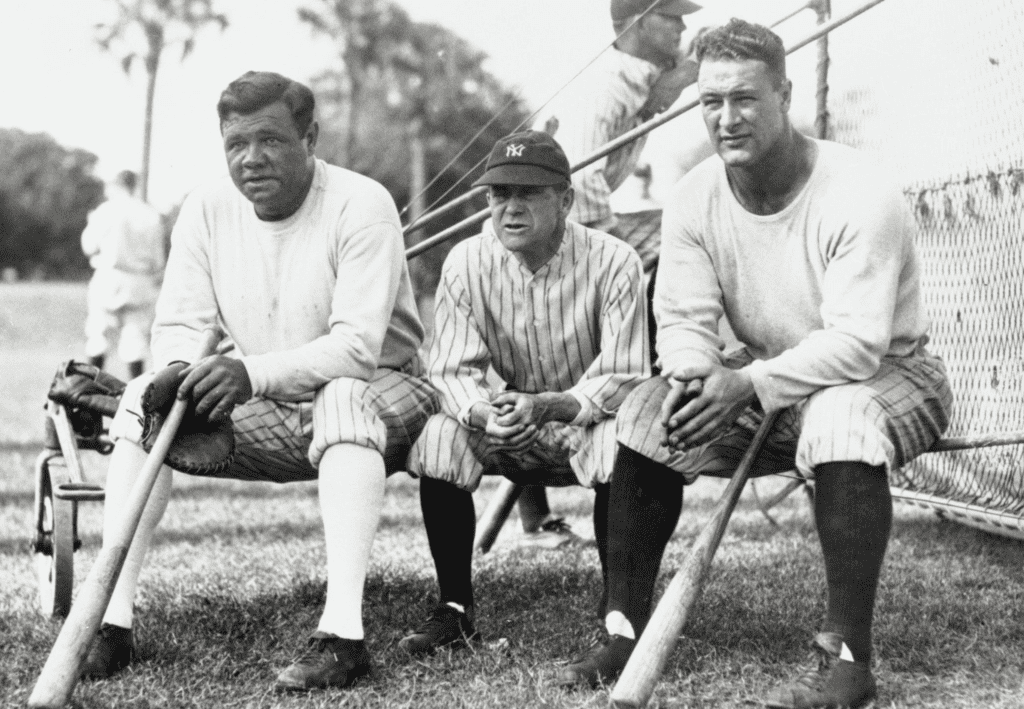
Lou Gehrig went to spring training with the Yankees in 1924, but the team couldn’t find him a permanent spot. The management wanted him to get more experience in the minors. So, Gehrig signed on with Hartford again. In 134 games, he hit .369 with 37 home runs, 40 doubles, and 13 triples. Huggins asked Gehrig to join the Yankees again in September when Hartford’s season was over.
Lou Gehrig did well in the few games he played. In 12 at-bats, he hit .500 and drove in five runs. The most interesting thing that happened during that short time was a game against the Detroit Tigers. Gehrig hit a two-run single to right field, but when he was going to first base, he turned too far and was caught. This led to a long chase, during which Ty Cobb ran in from the center field and tagged out the young slugger while Lou Gehrig was stuck.
Lou Gehrig was usually a quiet player who didn’t make a lot of noise on the field. Cobb, however, had made him very angry. He yelled as he walked off the field and continued to do so from the steps of the Yankees’ dugout. The umpire told Gehrig to be quiet, but he didn’t listen. After Lou Gehrig ignored another warning, the umpire kicked him out of the game, which made him even angry. When the game was over, Gehrig was still angry about the fight, so he went after Cobb in the tunnel between the dugout and the clubhouse. His Teammate Babe Ruth tried to hold him back, but Lou Gehrig broke free and punched the worst man in baseball history. Gehrig missed the haymaker, stumbled forward, and hit his head on the hard concrete floor. He was knocked out for a short time.
Huggins thought that Lou Gehrig was ready to join the Yankees in 1925. However, the Yankees already had a first baseman in Wally Pipp and he had just finished one of the best years of his career. He had been the starter for almost ten years, and at age 32, he was at the top of his game. So, even though Lou Gehrig had a lot of talent, the Yankees didn’t have a place for him on the field or in their lineup. During April and May, Gehrig was a backup player and pinch-hitter. Huggins decided on June 2 to start Gehrig and let Wally Pipp rest.
In his first game at the first base in 1925, Lou Gehrig batted sixth after BabeRuth and Bob Meusel and went 3-for-5 with a double. Huggins and the Yankees’ owners thought that Gehrig was the first baseman of the future and he pipped Pipp. Before the next game, the manager went to the team’s locker room and told Lou Gehrig, “You’re my first baseman today and from now on. Now, don’t freak out. Even if you miss a few, no one will shoot you.” It was the start of what would become the most well-known streak in sports history. Over 126 games, he hit .295 with 20 home runs and drove in 68 runs.
In 1926, Lou Gehrig kept getting better with .313, 47 doubles, 20 triples, 16 home runs, and 109 RBIs in 155 games for the Yankees. On August 13, he faced Walter Johnson of the Washington Senators, who had won 417 games in his career and no player ever hit him for two home runs in the same game. Lou Gehrig hit two of Johnson’s pitches over the right-field fence at Griffith Stadium and it catapulted the 23-year-old to instant fame.
On September 19, Lou Gehrig hit a home run and three doubles against the Cleveland Indians. This helped the Yankees beat the Indians and win the American League title for the first time since 1923. In the World Series of 1926, New York played St. Louis. Lou Gehrig drove in both of the Yankees’ runs in the 2-1 win in his first Fall Classic game. Overall in the Series, he hit .348, but the Yankees lost in seven games to the Cardinals.

In 1927, Lou Gehrig was part of a lineup that the New York press called “Murderers Row.” They were the best-hitting team in the American League in every way except for doubles, where they were second. In that year, though, the home run race between Babe Ruth and Lou Gehrig was the main attraction. Ruth faced a strong competitor for the first time in his career, and they hit home runs at the same rate for most of the season. By the end of May, Ruth had a 16–12 lead over Lou Gehrig. But by the end of June, they had each hit 25 home runs.
The odds favored Lou Gehrig. It was a bold prediction since Ruth was by far the best home run hitter baseball had ever seen, and Gehrig was only 24 years old at the time. By July’s end, Lou had 35 and Ruth had 34. The two kept hitting home runs all through August, and by Labor Day, each of them had 44. The next day, in the first game of a doubleheader, Lou Gehrig hit his 45th home run to take the lead. But the Babe responded by hitting two home runs in his next two at-bats and another in the second game to take a two-run lead. Ruth added two more the next day, giving her a lead of four. Then he went on a hot streak. In the last 21 games of the season, he hit 11 more home runs, giving him a new record of 60 home runs for the year. Lou Gehrig hit a slump at the end of the season and only hit two more home runs, giving him a total of 47. The whole Boston Red Sox team, on the other hand, only hit 28. The Cleveland Indians scored only 26 runs.
Lou Gehrig had a great year, even though he didn’t win the home run title. He hit .373, had 47 home runs, led the league in RBIs with 173, and set a new Yankees record with 52 doubles. Gehrig also had 18 triples, and his 117 extra-base hits are still the second most in major league history, just two less than Ruth’s 119 in 1921. Again, Gehrig played in all of the season’s games.
At the time, the Yankees’ record of 110 wins and 44 losses was the best in the history of the American League. In the World Series, they beat the Pittsburgh Pirates in three straight games. Gehrig had a decent series. He hit .308 and drove in four runs. Each player who won got $5,592, which was a nice bonus since Gehrig only made $8,000 for the whole season. In October, Gehrig was named the Most Valuable Player in the American League. A few weeks later, Lou Gehrig got a three-year contract that would pay him $25,000 a year.
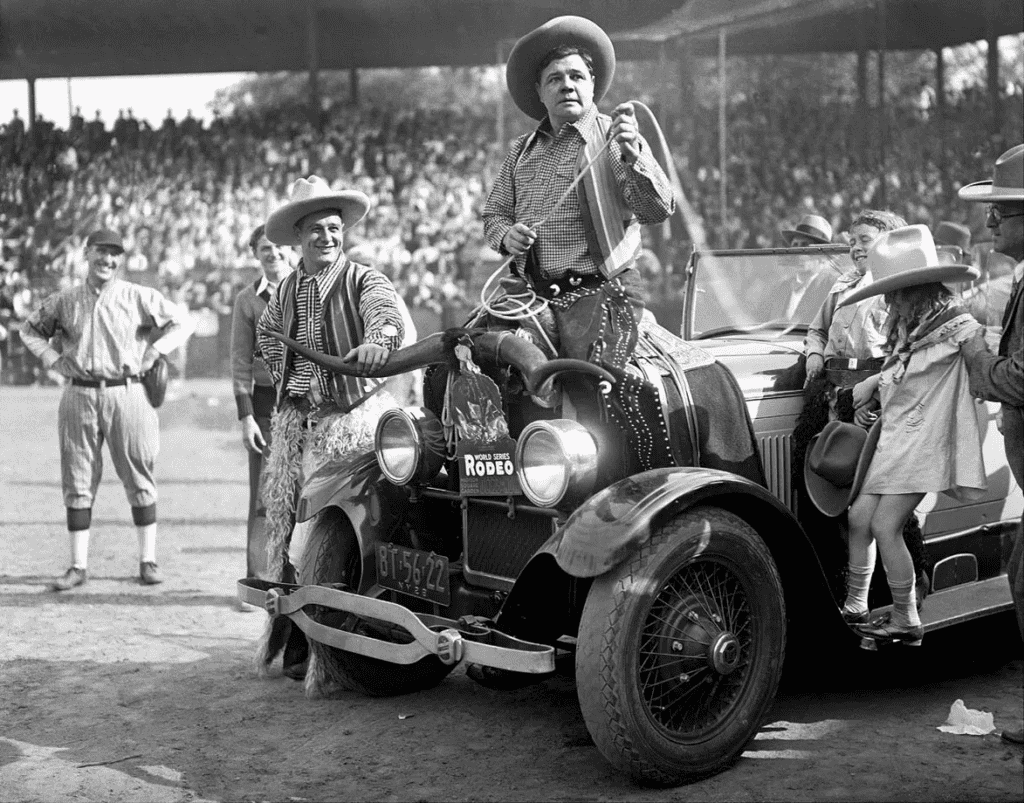
In the 1928 World Series, which the Yankees won against the Cardinals, Lou Gehrig had a monster Series. In the four games, he had a .545 batting average, two home runs, four RBIs, and a .545 slugging percentage.
The New York Yankees started putting numbers on their uniforms for the first time in 1929. Lou Gehrig wore number 4 because he came up in the lineup after Babe Ruth, who batted third. Gehrig had one of the best seasons of his career. He hit .379 and had 41 home runs and 174 RBIs to lead the league. Even more amazing is that Lou Gehrig played the last three weeks of the season with a broken finger that had to be fixed after the season was over. Doctors found bone chips in his left elbow while he was in the hospital. This was another injury that needed surgery. Even though Lou Gehrig was hurt, he still played in all of the Yankees’ games.
Lou Gehrig had another great year in 1931. With 184 RBIs, he set a new American League record that still stands today. He hit four home runs in a game on June 3, 1932, against the Philadelphia Athletics. Lou Gehrig was the first player in the 20th century to do this. After missing the playoffs for three years, the Yankees came back in 1932 and won the American League pennant. This was the third year in a row that Lou Gehrig drove in more than 150 runs. On June 3 at Shibe Park, against the Athletics, he had his best game of the season, and maybe of his whole career.
Lou Gehrig had the third-highest hits at Shibe Park after Yankee Stadium and Sportsman’s Park in St. Louis. In his first turn at bat, Gehrig hit a fastball from George Earnshaw over the left-center field fence. He again hit the pitcher for his second homer in his next at bat. The third home run came from another pitch by Earnshaw in the fifth inning. It was the first time in the history of the major leagues that Lou Gehrig had hit three home runs in one game. The Yankees beat the Chicago Cubs three times in a row in the 1932 World Series. Gehrig had a batting average of .529 with three home runs.
On July 6, 1933, the first All-Star game was played in Major League Baseball. Lou Gehrig got almost half a million votes from fans, which was more than three times as many as Jimmie Foxx, who came in second. Gehrig went to the plate four times during the game. He walked twice, grounded out, and struck out. 4–2 for the American League.
On August 17, 1933, Lou Gehrig played his 1,308th straight game against the St. Louis Browns at Sportsman’s Park. This ended Everett Scott’s record for the longest streak of consecutive games played. He hit .334 with 32 home runs and 139 runs.
Babe Ruth and Lou Gehrig played together for the last time during the 1934 season. The 32-year-old first baseman is only the third player in baseball history to lead both the American and National Leagues in batting average (.363), home runs (49), and RBIs (165). Gehrig started the 1935 season as the Yankees’ undisputed leader. On April 21, Joe McCarthy made Lou Gehrig the captain of the team. When Gehrig first heard about the job, he told his wife Eleanor that he wasn’t sure if he was the right person for it. Eleanor told him to take the title and lead by example, as he had always done. But because the players around Lou Gehrig were not very good, many pitchers chose to avoid him. Because of this, he walked 132 times, which was a career-high. This helped him lead the league in on-base percentage (.466) and runs scored (125).
In 1936, Lou Gehrig was clearly the better player, despite all the press and Joe DiMaggio‘s great first season. He had a batting average of .354, led the American League with 49 home runs and came in second with 152 RBIs. Gehrig also led the league in runs scored (167), times on base (478), slugging (.696), and on-base percentage (.478). (342). In October, for the second time in his career, he was named the Most Valuable Player of the American League.
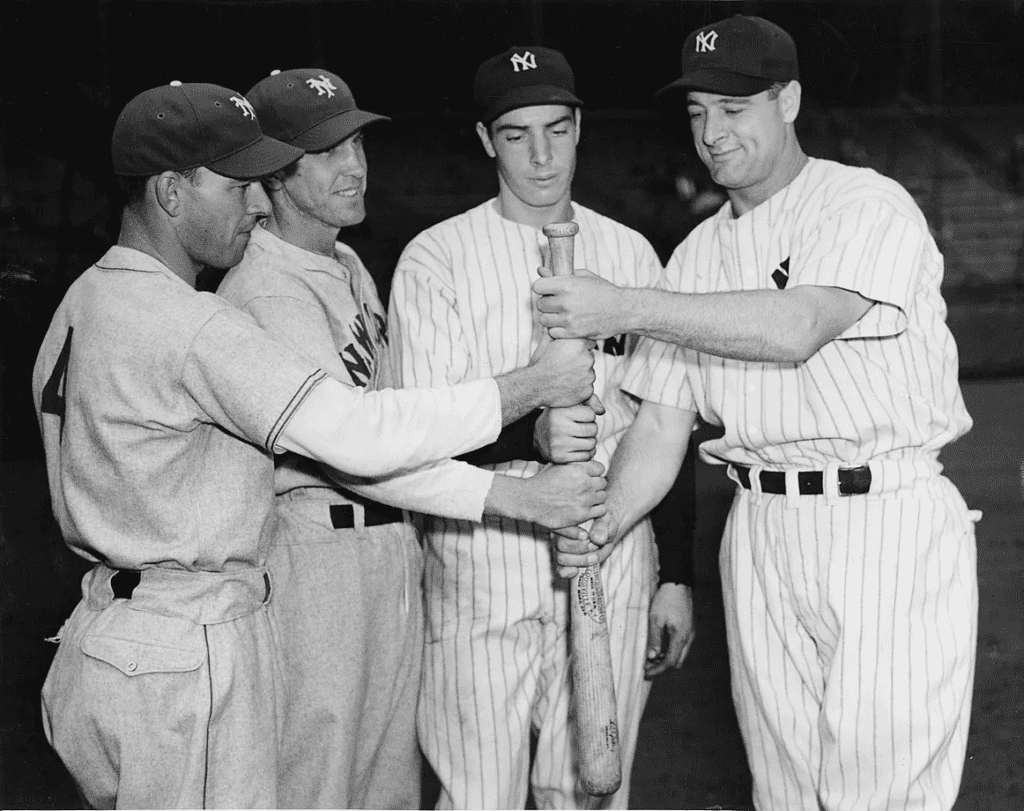
Lou Gehrig hit .292 with two home runs and seven RBIs in the World Series, helping the Yankees beat their rivals, the New York Giants. Gehrig’s last great season was in 1937. It was also the last time he was healthy enough to play baseball for a whole year. The Yankees won the pennant for the second year in a row, showing that they are still the best team in the American League. In just his second year, DiMaggio led the team in home runs (46) and RBIs (167), but Gehrig hit .351 and had 37 home runs and 159 RBIs to lead the team on average. Again, he played in every Yankees game, bringing the total number of games he has played in a row to an amazing 1,965.
In the World Series of 1937, the Yankees played the Giants again. Gehrig did well in the World Series, where he hit .294 and drove in 3 runs. Gehrig hit a home run off Carl Hubbell in the ninth inning of Game 4, just like he did in the 1936 World Series. It was the last of the 10 home runs he had hit in the World Series.
In 1938, Lou Gehrig was a few pounds overweight. This was the first time in his career that he was overweight. His 2,000th straight game was on May 31, 1938. That day his wife Eleanor suggested him to take a rest. She was worried about how the streak seemed to be affecting his body. But Lou Gehrig didn’t listen to her and went to the ballpark instead. He played that day and got a hit, making it 2,000 straight games with a hit. But as the summer went on, Gehrig started to get sick. Eleanor said, “Somewhere in the creeping mystery of that summer, Lou lost the power.” After five innings of a game against the Cleveland Indians, he had to leave because of pain in his back. A few days later, Lou Gehrig caught a low pitch from pitcher Spud Chandler, which badly jammed his thumb and put him out of the game in the seventh inning.
When the Yankees started spring training in St. Petersburg, Florida, in 1939, Lou Gehrig was no longer as powerful as he used to be. Even his base running was bad, and he fell over at one point. By the time the 1939 season started, Lou Gehrig had lost a lot of speed and coordination. Even though Gehrig struggled all season, he still had a good year in 1938. He hit .295 with 29 home runs and 114 RBIs.

The Yankees beat the Red Sox by 9 1/2 games to win their third straight American League title. In the World Series, they beat the Cubs in three straight games. Lou Gehrig had a batting average of .286, but he didn’t get any extra-base hits.
Lou Gehrig kept feeling tired and weak all through the winter. When Gehrig tried to put on his uniform pants one afternoon in the clubhouse, he fell down. Pete Sheehy, who worked in the clubhouse, and DiMaggio ran over to help the Yankee captain who had fallen. On May 2, after a day off, Lou Gehrig went up to McCarthy before the game against the Tigers in Detroit and told him, “I’m sitting myself down, Joe.” He never played in another major league game after 2,130. The next day, newspapers across the country carried a picture from a wire service of Gehrig sitting still on the dugout steps.

As Lou Gehrig’s illness got steadily worse, his wife Eleanor called the Mayo Clinic in Rochester, Minnesota. Charles William Mayo, who had been following Gehrig’s career and his strange loss of strength, got her call. Mayo told Eleanor to hurry up and bring Gehrig. On June 13, 1939, Gehrig flew to Rochester by himself. After six days of thorough testing at the clinic, doctors told Gehrig on his 36th birthday, June 19, 1939, that he had amyotrophic lateral sclerosis (ALS). The prognosis was bad, a paralysis that was getting worse quickly, trouble swallowing and speaking, and a life expectancy of fewer than three years, but no loss of mental abilities. Eleanor Gehrig was told that no one knew what caused ALS, but that it was painful, not contagious, and cruel. The disease destroys the motor function of the central nervous system, but the mind stays fully aware until the end.
On June 19, 1939, the doctors at the Mayo Clinic made the diagnosis public. The New York Yankees told everyone two days later that Lou Gehrig was retiring. Tuesday, July 4, 1939, was called “Lou Gehrig Appreciation Day” at Yankee Stadium by the team. The ceremonies took place on the field between the two Independence Day games against the Washington Senators, and 61,808 fans were there to see them.

The Yankees took Lou Gehrig’s number 4 off the field, making him the first player in the history of Major League Baseball to get this honor. Gehrig gave a speech at Yankee Stadium that has been called “baseball’s Gettysburg Address.” The stadium was packed with people. Lou Gehrig never liked being in the spotlight, so he didn’t want to talk. But the crowd chanted for him, and he had already learned some things to say. The emotional farewell speech by Lou Gehrig is famous as the “Luckiest Man speech.”
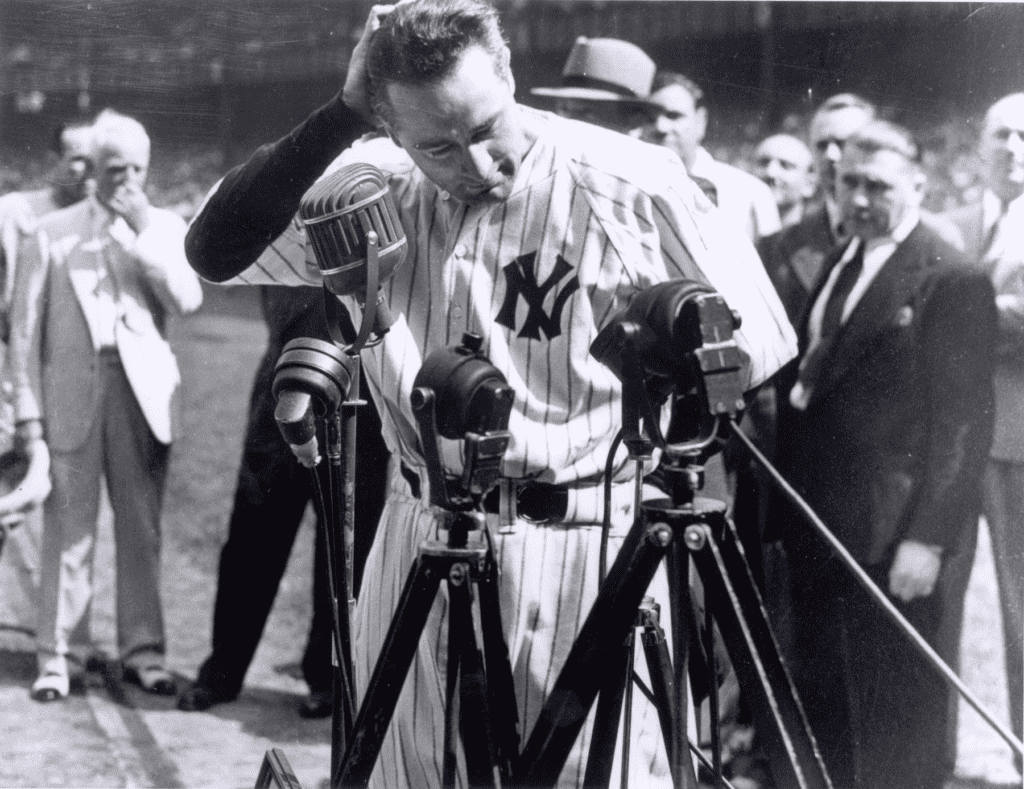
Gehrig spoke:
“I consider myself the luckiest man on the face of the earth. I have been in ballparks for seventeen years and have never received anything but kindness and encouragement from you fans.”
“So I close in saying that I might have been given a bad break, but I’ve got an awful lot to live for. Thank you.”
On April 30, 1939, Lou Gehrig played his last game for the Yankees. On July 11, of that year, he was the captain of the American League team and played in the All-Star Game at Yankee Stadium as a reserve player. In 1939, Gehrig was chosen for the Baseball Hall of Fame.
Lou Gehrig died at his home at 5204 Delafield Avenue in the Riverdale neighborhood of the Bronx, New York, at 10:10 p.m. on June 2, 1941, 17 days before his 38th birthday.
From 1935 until his death in 1941, Lou Gehrig was the captain of the Yankees. In 1969, the Baseball Writers’ Association of America chose him as the best first baseman of all time. On the 50th anniversary of the end of his streak, which was in 1989, a US postage stamp was made in his honor. In 1999, he got the most votes for the All-Century Team of Major League Baseball.
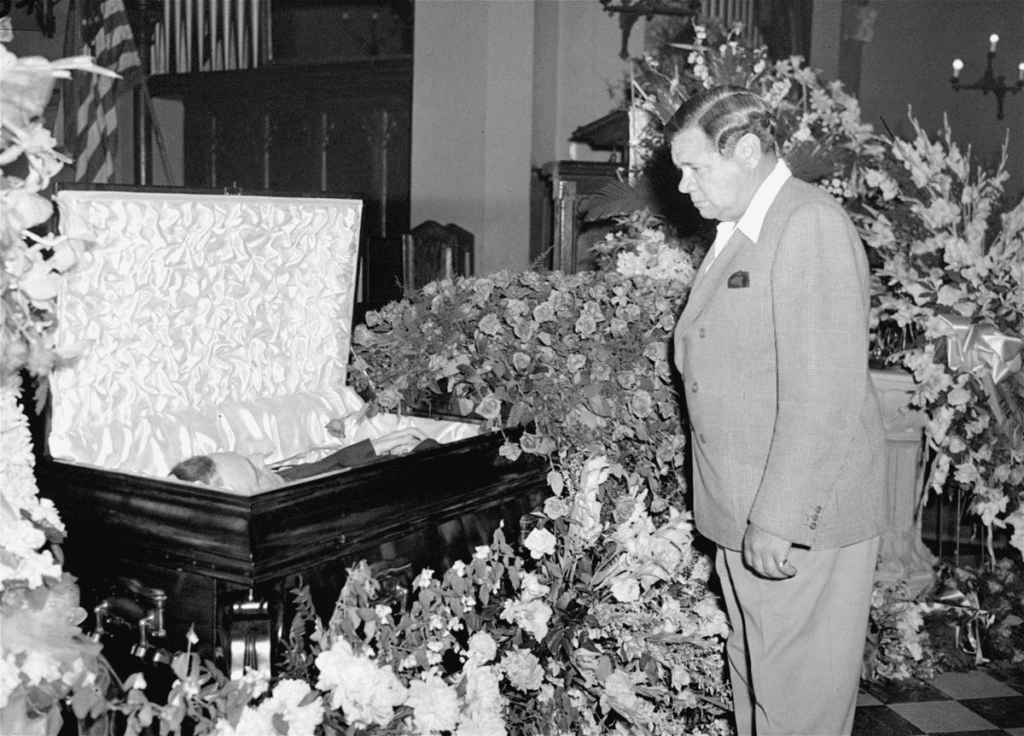
Lou Gehrig was one of the best run producers in baseball history. Over the course of three years, he had 509 RBIs (1930–32). Gehrig hit at least .350 in six seasons, with a high of.379 in 1930. He also hit .349 in the seventh season. Lou Gehrig was the American League leader four times in runs scored, three times in home runs, and five times in RBIs. His 185 RBIs in 1931 are still the American League record as of 2023. He also has the baseball record for the most seasons with 400 or more total bases. Lou Gehrig did this five times in his career.
The Lou Gehrig Memorial Award is given every year to the MLB player who, on and off the field, best shows the character and integrity of Gehrig. The MLB began celebrating June 2 as Lou Gehrig Day in 2021.
Major League Baseball said in March 2021 that June 2 would always be Lou Gehrig Day. The date was chosen because it was on June 2 that Lou Gehrig started playing first base for the Yankees in 1925 and the day he died in 1941. The 1942 movie The Pride of the Yankees was about Lou Gehrig’s life. Gary Cooper played Gehrig and Teresa Wright played his wife. It was nominated for 11 Academy Awards and won one, for Film Editing. Babe Ruth, Bob Meusel, Mark Koenig, and Bill Dickey, who was still playing at the time, were all in the movie, as was sportscaster Bill Stern. In 2008, The Pride of the Yankees was named the third-best sports movie ever made by the AFI.
Lou Gehrig’s Greatest Moments
- 6-time AL All-Star player (1933-1938)
- 2-time AL MVP (1927 & 1936)
- AL Triple Crown (1934)
- AL Batting Average Leader (1934)
- 5-time AL On-Base Percentage Leader (1928 & 1934-1937)
- 2-time AL Slugging Percentage Leader (1934 & 1936)
- 3-time AL OPS Leader (1934, 1936 & 1937)
- 4-time AL Runs Scored Leader (1931, 1933, 1935 & 1936)
- AL Hits Leader (1931)
- 4-time AL Total Bases Leader (1927, 1930, 1931 & 1934)
- 2-time AL Doubles Leader (1927 & 1928)
- AL Triples Leader (1926)
- 3-time AL Home Runs Leader (1931, 1934 & 1936)
- 5-time AL RBI Leader (1927, 1928, 1931, 1932 & 1934)
- 3-time AL Bases on Balls Leader (1935-1937)
- 20-Home Run Seasons: 13 (1925 & 1927-1938)
- 30-Home Run Seasons: 10 (1927 & 1929-1937)
- 40-Home Run Seasons: 5 (1927, 1930, 1931, 1934 & 1937)
- 100 RBI Seasons: 13 (1926-1938)
- 100 Runs Scored Seasons: 13 (1926-1938)
- 200 Hits Seasons: 8 (1927, 1928, 1930-1932, 1934, 1936 & 1937)
- Seven World Series rings (1927, 1928, 1932, 1936, 1937, 1938 & 1939; he did not play in the 1939 World Series)
- Baseball Hall of Fame: Class of 1939
FAQs about Lou Gehrig
When is Lou Gehrig day?
June 2
Why was Lou Gehrig called the iron horse?
Lou Gehrig was renowned for his hitting prowess and durability, which earned him his nickname “the Iron Horse”.
What was Lou Gehrig’s jersey number?
4
Who did Lou Gehrig replace?
Wally Pipp
How long did Lou Gehrig have ALS?
Roughly three years
Where did Lou Gehrig live?
Riverdale, Bronx, Manhattan
How long did Lou Gehrig live after he was diagnosed?
The disease forced him to retire at age 36 and claimed his life two years later.
Who is Lou Gehrig’s disease named after?
French neurologist Jean-Martin Charcot
When did Lou Gehrig get ALS?
Diagnosed on June 19, 1939
What did Lou Gehrig die from?
Amyotrophic Lateral Sclerosis
How old was Lou Gehrig when he died?
37 years
How tall was Lou Gehrig?
1.83 m
What year did Lou Gehrig die?
June 2, 1941
Why did Lou Gehrig retire?
Lou Gehrig had been forced to retire as a player after being diagnosed with amyotrophic lateral sclerosis.
What happened to Lou Gehrig?
In 1939, Lou Gehrig was diagnosed with a rare nervous system disorder, amyotrophic lateral sclerosis and had to retire.
What are the early symptoms of Lou Gehrig disease?
Early symptoms include:
1. Muscle twitches in the arm, leg, shoulder, or tongue.
2. Muscle cramps.
3. Tight and stiff muscles (spasticity)
4. Muscle weakness affecting an arm, a leg, the neck, or diaphragm.
5. Slurred and nasal speech.
6. Difficulty chewing or swallowing.
Who did Lou Gehrig play for?
New York Yankees
When did Lou Gehrig play baseball?
Lou Gehrig joined the Yankees MLB team on June 15, 1923.
How long did Lou Gehrig play baseball?
17 years
How old was Lou Gehrig when he retired?
Aged 36
What position did Lou Gehrig play?
First baseman, Pinch hitter
When was Lou Gehrig born?
June 19, 1903
Where was Lou Gehrig born?
Yorkville, New York, United States
What year did Lou Gehrig retire?
1939
What is Lou Gehrig disease or ALS?
It is a progressive nervous system disorder that affects nerve cells in the brain and spinal cord, causing loss of muscle control.
What was Lou Gehrig famous for?
Lou Gehrig played 2,130 consecutive games for the Yankees and scripted many records. His No. 4 was the first to be retired by the Yankees.
Who replaced Lou Gehrig?
Babe Dahlgren
What is Lou Gehrig known for?
Lou Gehrig hit 493 home runs, held the record for most grand slams, and established a record for playing 2,130 consecutive professional baseball games.
Who played first base before Lou Gehrig?
Wally Pipp
How much is a Lou Gehrig rookie card worth?
On average, a Rookie Card of Lou Gehrig is valued at $10.95.
How much is Lou Gehrig’s signature worth?
A Lou Gehrig-signed baseball is worth $30,000 -$65,000. A Lou Gehrig autographed photo would be in the $5,500-$8,000 price range.
How long did Lou Gehrig live after his speech?
Two years
What day did Lou Gehrig retire?
April 30, 1939
How long did Lou Gehrig live after diagnosis?
Two years
When did Lou Gehrig develop ALS?
Gehrig was diagnosed with ALS on his 36th birthday on June 19, 1939.
How long can someone live with Lou Gehrig disease?
Two to five years
The Stats
| SUMMARY | WAR | AB | H | HR | BA | R | RBI | SB | OBP | SLG | OPS | OPS+ |
| Career | 113.6 | 8001 | 2721 | 493 | .340 | 1888 | 1995 | 102 | .444 | .632 | 1.076 | 178 |
Lou Gehrig’s Standard Batting Record
| Year | G | PA | AB | R | H | 2B | 3B | HR | RBI | SB | CS | BB | SO | BA | OBP | SLG | OPS | OPS+ | TB | GDP | HBP | SH | SF | IBB | Pos |
| 1923 | 13 | 29 | 26 | 6 | 11 | 4 | 1 | 1 | 8 | 0 | 0 | 2 | 5 | 0.423 | 0.464 | 0.769 | 1.234 | 218 | 20 | 0 | 1 | /3H | |||
| 1924 | 10 | 13 | 12 | 2 | 6 | 1 | 0 | 0 | 5 | 0 | 0 | 1 | 3 | 0.5 | 0.538 | 0.583 | 1.122 | 191 | 7 | 0 | 0 | 0 | 0 | /H39 | |
| 1925 | 126 | 497 | 437 | 73 | 129 | 23 | 10 | 20 | 68 | 6 | 3 | 46 | 49 | 0.295 | 0.36 | 0.531 | 0.891 | 127 | 232 | 2 | 5 | 7 | 3 | *3/H97 | |
| 1926 | 155 | 697 | 572 | 135 | 179 | 47 | 20 | 16 | 109 | 6 | 5 | 105 | 73 | 0.313 | 0.413 | 0.549 | 0.962 | 152 | 314 | 1 | 6 | 12 | 0 | *3 | |
| 1927 | 155 | 717 | 584 | 149 | 218 | 52 | 18 | 47 | 173 | 10 | 10 | 109 | 84 | 0.373 | 0.463 | 0.765 | 1.229 | 219 | 447 | 3 | 5 | 16 | 9 | *3 | |
| 1928 | 154 | 678 | 562 | 139 | 210 | 47 | 13 | 27 | 147 | 4 | 11 | 95 | 69 | 0.374 | 0.456 | 0.648 | 1.103 | 191 | 364 | 4 | 0 | 17 | 3 | *3 | |
| 1929 | 154 | 694 | 553 | 127 | 166 | 32 | 10 | 35 | 125 | 4 | 3 | 122 | 68 | 0.3 | 0.423 | 0.584 | 1.007 | 165 | 323 | 5 | 0 | 12 | 9 | *3 | |
| 1930 | 154 | 703 | 581 | 143 | 220 | 42 | 17 | 41 | 173 | 12 | 14 | 101 | 63 | 0.379 | 0.462 | 0.721 | 1.183 | 202 | 419 | 3 | 1 | 17 | 3 | *3/7 | |
| 1931 | 155 | 738 | 619 | 163 | 211 | 31 | 15 | 46 | 185 | 17 | 12 | 117 | 56 | 0.341 | 0.446 | 0.662 | 1.108 | 194 | 410 | 0 | 2 | 14 | *3/9 | ||
| 1932 | 156 | 708 | 596 | 138 | 208 | 42 | 9 | 34 | 151 | 4 | 11 | 108 | 38 | 0.349 | 0.451 | 0.621 | 1.072 | 181 | 370 | 3 | 1 | 7 | *3 | ||
| 1933 | 152 | 687 | 593 | 138 | 198 | 41 | 12 | 32 | 140 | 9 | 13 | 92 | 42 | 0.334 | 0.424 | 0.605 | 1.03 | 177 | 359 | 1 | 1 | 4 | *3 | ||
| 1934 | 154 | 690 | 579 | 128 | 210 | 40 | 6 | 49 | 166 | 9 | 5 | 109 | 31 | 0.363 | 0.465 | 0.706 | 1.172 | 207 | 409 | 2 | 0 | 13 | *3/6 | ||
| 1935 | 149 | 673 | 535 | 125 | 176 | 26 | 10 | 30 | 120 | 8 | 7 | 132 | 38 | 0.329 | 0.466 | 0.583 | 1.049 | 175 | 312 | 5 | 0 | 21 | *3 | ||
| 1936 | 155 | 719 | 579 | 167 | 205 | 37 | 7 | 49 | 152 | 3 | 4 | 130 | 46 | 0.354 | 0.478 | 0.696 | 1.174 | 190 | 403 | 7 | 3 | 9 | *3 | ||
| 1937 | 157 | 700 | 569 | 138 | 200 | 37 | 9 | 37 | 158 | 4 | 3 | 127 | 49 | 0.351 | 0.473 | 0.643 | 1.116 | 176 | 366 | 4 | 0 | 13 | *3 | ||
| 1938 | 157 | 689 | 576 | 115 | 170 | 32 | 6 | 29 | 114 | 6 | 1 | 107 | 75 | 0.295 | 0.41 | 0.523 | 0.932 | 132 | 301 | 5 | 1 | 6 | *3 | ||
| 1939 | 8 | 33 | 28 | 2 | 4 | 0 | 0 | 0 | 1 | 0 | 0 | 5 | 1 | 0.143 | 0.273 | 0.143 | 0.416 | 10 | 4 | 2 | 0 | 0 | 0 | 0 | /3 |
| 17 Yrs | 2164 | 9665 | 8001 | 1888 | 2721 | 534 | 163 | 493 | 1995 | 102 | 102 | 1508 | 790 | 0.34 | 0.444 | 0.632 | 1.076 | 178 | 5060 | 2 | 45 | 26 | 81 | 114 | |
| 162 Game Avg. | 162 | 724 | 599 | 141 | 204 | 40 | 12 | 37 | 149 | 8 | 8 | 113 | 59 | 0.34 | 0.444 | 0.632 | 1.076 | 178 | 379 | 3 | 2 | ||||
| G | PA | AB | R | H | 2B | 3B | HR | RBI | SB | CS | BB | SO | BA | OBP | SLG | OPS | OPS+ | TB | GDP | HBP | SH | SF | IBB | Pos |
Lou Gehrig’s Postseason Batting Record
| Year | G | PA | AB | R | H | 2B | 3B | HR | RBI | SB | CS | BB | SO | BA | OBP | SLG | OPS | TB | GDP | HBP | SH | SF | IBB | WPA | cWPA |
| 1926 | 7 | 29 | 23 | 1 | 8 | 2 | 0 | 0 | 4 | 0 | 0 | 5 | 4 | 0.348 | 0.464 | 0.435 | 0.899 | 10 | 0 | 1 | 1 | 0.17 | 8.60% | ||
| 1927 | 4 | 18 | 13 | 2 | 4 | 2 | 2 | 0 | 4 | 0 | 0 | 3 | 3 | 0.308 | 0.438 | 0.769 | 1.207 | 10 | 0 | 0 | 0 | 0.19 | 9.20% | ||
| 1928 | 4 | 17 | 11 | 5 | 6 | 1 | 0 | 4 | 9 | 0 | 0 | 6 | 0 | 0.545 | 0.706 | 1.727 | 2.433 | 19 | 0 | 0 | 1 | 0.99 | 21.90% | ||
| 1932 | 4 | 20 | 17 | 9 | 9 | 1 | 0 | 3 | 8 | 0 | 0 | 2 | 1 | 0.529 | 0.6 | 1.118 | 1.718 | 19 | 1 | 0 | 0 | 0.83 | 19.10% | ||
| 1936 | 6 | 28 | 24 | 5 | 7 | 1 | 0 | 2 | 7 | 0 | 1 | 3 | 2 | 0.292 | 0.393 | 0.583 | 0.976 | 14 | 1 | 0 | 0 | -0.01 | 2.10% | ||
| 1937 | 5 | 22 | 17 | 4 | 5 | 1 | 1 | 1 | 3 | 0 | 0 | 5 | 4 | 0.294 | 0.455 | 0.647 | 1.102 | 11 | 0 | 0 | 1 | 0.08 | 2.40% | ||
| 1938 | 4 | 16 | 14 | 4 | 4 | 0 | 0 | 0 | 0 | 0 | 0 | 2 | 3 | 0.286 | 0.375 | 0.286 | 0.661 | 4 | 0 | 0 | 0 | 0.05 | 0.80% | ||
| 1939 | Did not play in series | ||||||||||||||||||||||||
| 7 Yrs (7 Series) | 34 | 150 | 119 | 30 | 43 | 8 | 3 | 10 | 35 | 0 | 1 | 26 | 17 | 0.361 | 0.483 | 0.731 | 1.214 | 87 | 2 | 1 | 3 | 2.3 | 64.10% | ||
| 8 WS | 34 | 150 | 119 | 30 | 43 | 8 | 3 | 10 | 35 | 0 | 1 | 26 | 17 | 0.361 | 0.483 | 0.731 | 1.214 | 87 | 2 | 1 | 3 | 2.3 | 64.10% |
Lou Gehrig’s Career Graph
| Hall of Fame | All-Star Games | Awards | MVP (rank, share) |
| 1936 BBWAA (22.6%) 1939 Special Election (inducted) Selected to HOF in 1939 by Special Election | 1933 (1B) 1934 (1B) 1935 (1B) 1936 (1B) 1937 (1B) 1938 * 1939 | 1927 AL MVP 1934 AL Batting Title 1934 AL Triple Crown 1936 AL MVP | 1925 AL (24, 3%) 1926 AL (10, 11%) 1927 AL (1, 88%) 1931 AL (2, 74%) 1932 AL (2, 69%) 1933 AL (4, 49%) 1934 AL (5, 68%) 1935 AL (5, 36%) 1936 AL (1, 91%) 1937 AL (4, 53%) 1938 AL (19, 3%) 2 MVPs 5.45 Career Shares (8th) |
| Wins Above Replacement | WAR Position Players | Offensive WAR | Batting Average |
| 1926 AL 6.9 (4th) 1927 AL 11.9 (2nd) 1928 AL 9.5 (2nd) 1929 AL 7.5 (5th) 1930 AL 9.6 (3rd) 1931 AL 8.6 (3rd) 1932 AL 8.1 (4th) 1933 AL 7.2 (4th) 1934 AL 10.1 (1st) 1935 AL 8.4 (4th) 1936 AL 9.7 (2nd) 1937 AL 8.2 (4th) Career 113.6 (18th) | 1926 AL 6.9 (3rd) 1927 AL 11.9 (2nd) 1928 AL 9.5 (2nd) 1929 AL 7.5 (5th) 1930 AL 9.6 (2nd) 1931 AL 8.6 (2nd) 1932 AL 8.1 (3rd) 1933 AL 7.2 (3rd) 1934 AL 10.1 (1st) 1935 AL 8.4 (2nd) 1936 AL 9.7 (1st) 1937 AL 8.2 (2nd) Career 113.6 (13th) | 1926 AL 6.3 (3rd) 1927 AL 11.4 (1st) 1928 AL 9.0 (2nd) 1929 AL 7.2 (4th) 1930 AL 9.9 (2nd) 1931 AL 9.3 (2nd) 1932 AL 8.6 (2nd) 1933 AL 7.9 (2nd) 1934 AL 9.9 (1st) 1935 AL 7.6 (1st) 1936 AL 9.8 (1st) 1937 AL 8.8 (1st) 1938 AL 4.8 (10th) Career 113.6 (14th) | 1927 AL .373 (3rd) 1928 AL .374 (3rd) 1930 AL .379 (2nd) 1931 AL .341 (5th) 1932 AL .349 (3rd) 1933 AL .334 (3rd) 1934 AL .363 (1st) 1935 AL .329 (6th) 1936 AL .354 (5th) 1937 AL .351 (2nd) Career .340 (20th) |
| On-Base% | Slugging % | On-Base Plus Slugging | Games Played |
| 1926 AL .420 (9th) 1927 AL .474 (3rd) 1928 AL .467 (1st) 1929 AL .431 (2nd) 1930 AL .473 (2nd) 1931 AL .446 (3rd) 1932 AL .451 (4th) 1933 AL .424 (5th) 1934 AL .465 (1st) 1935 AL .466 (1st) 1936 AL .478 (1st) 1937 AL .473 (1st) Career .444 (7th) | 1926 AL .549 (4th) 1927 AL .765 (2nd) 1928 AL .648 (2nd) 1929 AL .584 (4th) 1930 AL .721 (2nd) 1931 AL .662 (2nd) 1932 AL .621 (3rd) 1933 AL .605 (2nd) 1934 AL .706 (1st) 1935 AL .583 (3rd) 1936 AL .696 (1st) 1937 AL .643 (4th) Career .632 (3rd) | 1926 AL .969 (4th) 1927 AL 1.240 (2nd) 1928 AL 1.115 (2nd) 1929 AL 1.015 (4th) 1930 AL 1.194 (2nd) 1931 AL 1.108 (2nd) 1932 AL 1.072 (3rd) 1933 AL 1.030 (2nd) 1934 AL 1.172 (1st) 1935 AL 1.049 (2nd) 1936 AL 1.174 (1st) 1937 AL 1.116 (1st) Career 1.076 (3rd) | 1926 AL 155 (2nd) 1927 AL 155 (1st) 1928 AL 154 (3rd) 1929 AL 154 (3rd) 1930 AL 154 (1st) 1931 AL 155 (2nd) 1932 AL 156 (1st) 1933 AL 152 (5th) 1934 AL 154 (1st) 1936 AL 155 (1st) 1937 AL 157 (1st) 1938 AL 157 (1st) Career 2,164 (162nd) |
| At Bats | Plate Appearances | Runs Scored | Hits |
| 1927 AL 584 (5th) 1928 AL 562 (7th) 1931 AL 619 (3rd) 1932 AL 596 (10th) 1933 AL 593 (9th) Career 8,001 (151st) | 1926 AL 697 (3rd) 1927 AL 717 (2nd) 1928 AL 678 (8th) 1929 AL 694 (5th) 1930 AL 703 (1st) 1931 AL 738 (1st) 1932 AL 708 (3rd) 1933 AL 687 (5th) 1934 AL 690 (5th) 1936 AL 719 (4th) 1937 AL 700 (8th) 1938 AL 689 (6th) Career 9,665 (110th) | 1926 AL 135 (2nd) 1927 AL 149 (2nd) 1928 AL 139 (2nd) 1929 AL 127 (3rd) 1930 AL 143 (4th) 1931 AL 163 (1st) 1932 AL 138 (4th) 1933 AL 138 (1st) 1934 AL 128 (3rd) 1935 AL 125 (1st) 1936 AL 167 (1st) 1937 AL 138 (3rd) 1938 AL 115 (10th) Career 1,888 (13th) | 1927 AL 218 (2nd) 1928 AL 210 (2nd) 1930 AL 220 (2nd) 1931 AL 211 (1st) 1932 AL 208 (4th) 1933 AL 198 (5th) 1934 AL 210 (2nd) 1936 AL 205 (7th) 1937 AL 200 (8th) Career 2,721 (64th) |
| Total Bases | Doubles | Triples | Home Runs |
| 1926 AL 314 (3rd) 1927 AL 447 (1st) 1928 AL 364 (3rd) 1929 AL 323 (5th) 1930 AL 419 (1st) 1931 AL 410 (1st) 1932 AL 370 (2nd) 1933 AL 359 (2nd) 1934 AL 409 (1st) 1935 AL 312 (5th) 1936 AL 403 (2nd) 1937 AL 366 (3rd) 1938 AL 301 (6th) Career 5,060 (20th) | 1926 AL 47 (5th) 1927 AL 52 (1st) 1928 AL 47 (1st) 1930 AL 42 (7th) 1932 AL 42 (4th) 1933 AL 41 (6th) 1934 AL 40 (9th) Career 534 (42nd) | 1926 AL 47 (5th) 1927 AL 52 (1st) 1928 AL 47 (1st) 1930 AL 42 (7th) 1932 AL 42 (4th) 1933 AL 41 (6th) 1934 AL 40 (9th) Career 534 (42nd) | 1925 AL 20 (5th) 1926 AL 16 (6th) 1927 AL 47 (2nd) 1928 AL 27 (2nd) 1929 AL 35 (2nd) 1930 AL 41 (2nd) 1931 AL 46 (1st) 1932 AL 34 (4th) 1933 AL 32 (3rd) 1934 AL 49 (1st) 1935 AL 30 (3rd) 1936 AL 49 (1st) 1937 AL 37 (3rd) 1938 AL 29 (7th) Career 493 (29th) |
| Runs Batted In | Bases on Balls | Strikeouts | Stolen Bases |
| 1926 AL 109 (5th) 1927 AL 173 (1st) 1928 AL 147 (1st) 1929 AL 125 (4th) 1930 AL 173 (1st) 1931 AL 185 (1st) 1932 AL 151 (2nd) 1933 AL 140 (2nd) 1934 AL 166 (1st) 1935 AL 120 (2nd) 1936 AL 152 (2nd) 1937 AL 158 (3rd) 1938 AL 114 (7th) Career 1,995 (7th) | 1926 AL 105 (4th) 1927 AL 109 (2nd) 1928 AL 95 (4th) 1929 AL 122 (3rd) 1930 AL 101 (3rd) 1931 AL 117 (3rd) 1932 AL 108 (4th) 1933 AL 92 (6th) 1934 AL 109 (2nd) 1935 AL 132 (1st) 1936 AL 130 (1st) 1937 AL 127 (1st) 1938 AL 107 (5th) Career 1,508 (17th) | 1925 AL 49 (10th) 1926 AL 73 (3rd) 1927 AL 84 (2nd) 1928 AL 69 (3rd) 1929 AL 68 (2nd) 1930 AL 63 (3rd) 1931 AL 56 (7th) 1938 AL 75 (6th) | 1931 AL 17 (6th) |
| Singles | Adjusted OPS+ | Runs Created | Adj. Batting Runs |
| 1928 AL 123 (10th) 1932 AL 123 (10th) Career 1,531 (197th) | 1926 AL 153 (5th) 1927 AL 220 (2nd) 1928 AL 193 (2nd) 1929 AL 166 (3rd) 1930 AL 203 (2nd) 1931 AL 194 (2nd) 1932 AL 181 (3rd) 1933 AL 177 (2nd) 1934 AL 207 (1st) 1935 AL 175 (2nd) 1936 AL 190 (1st) 1937 AL 176 (1st) Career 178 (5th) | 1926 AL 131 (2nd) 1927 AL 208 (1st) 1928 AL 164 (2nd) 1929 AL 137 (5th) 1930 AL 192 (1st) 1931 AL 180 (2nd) 1932 AL 161 (2nd) 1933 AL 147 (2nd) 1934 AL 189 (1st) 1935 AL 143 (3rd) 1936 AL 189 (1st) 1937 AL 171 (2nd) 1938 AL 123 (6th) Career 2,232 (10th) | 1926 AL 46 (2nd) 1927 AL 105 (1st) 1928 AL 80 (2nd) 1929 AL 59 (3rd) 1930 AL 94 (2nd) 1931 AL 85 (2nd) 1932 AL 75 (3rd) 1933 AL 66 (2nd) 1934 AL 93 (1st) 1935 AL 67 (2nd) 1936 AL 87 (1st) 1937 AL 73 (1st) Career 979 (5th) |
| Adj. Batting Wins | Extra Base Hits | Times On Base | Offensive Win % |
| 1926 AL 4.5 (2nd) 1927 AL 9.7 (1st) 1928 AL 7.5 (2nd) 1929 AL 5.5 (3rd) 1930 AL 8.4 (2nd) 1931 AL 7.9 (2nd) 1932 AL 6.9 (3rd) 1933 AL 6.3 (2nd) 1934 AL 8.5 (1st) 1935 AL 6.2 (2nd) 1936 AL 7.6 (1st) 1937 AL 6.6 (1st) Career 90.0 (7th) | 1926 AL 83 (1st) 1927 AL 117 (1st) 1928 AL 87 (2nd) 1929 AL 77 (4th) 1930 AL 100 (1st) 1931 AL 92 (1st) 1932 AL 85 (2nd) 1933 AL 85 (2nd) 1934 AL 95 (2nd) 1935 AL 66 (5th) 1936 AL 93 (2nd) 1937 AL 83 (4th) 1938 AL 67 (7th) Career 1,190 (11th) | 1926 AL 285 (3rd) 1927 AL 330 (1st) 1928 AL 309 (2nd) 1929 AL 293 (2nd) 1930 AL 324 (1st) 1931 AL 328 (1st) 1932 AL 319 (2nd) 1933 AL 291 (2nd) 1934 AL 321 (1st) 1935 AL 313 (2nd) 1936 AL 342 (1st) 1937 AL 331 (1st) 1938 AL 282 (5th) Career 4,274 (33rd) | 1926 AL .744 (6th) 1927 AL .875 (2nd) 1928 AL .836 (2nd) 1929 AL .753 (4th) 1930 AL .840 (2nd) 1931 AL .824 (3rd) 1932 AL .803 (3rd) 1933 AL .785 (2nd) 1934 AL .859 (1st) 1935 AL .793 (2nd) 1936 AL .830 (1st) 1937 AL .823 (1st) Career .803 (10th) |
| Hit By Pitch | Sacrifice Hits | Intentional Bases on Balls | Caught Stealing |
| 1929 AL 5 (6th) 1935 AL 5 (5th) 1936 AL 7 (4th) 1938 AL 5 (3rd) | 1930 AL 18 (10th) | 1928 AL 3 (8th) 1929 AL 9 (1st) 1930 AL 3 (7th) 1931 AL 14 (1st) 1932 AL 7 (5th) 1934 AL 13 (3rd) 1935 AL 21 (1st) 1936 AL 9 (4th) 1937 AL 13 (2nd) Career 114 (106th) | 1928 AL 11 (6th) 1930 AL 14 (2nd) 1931 AL 12 (6th) 1932 AL 11 (4th) 1933 AL 13 (2nd) 1935 AL 7 (9th) Career 102 (127th) |
| Power-Speed # | AB per SO | AB per HR | Base-Out Runs Added (RE24) |
| 1926 AL 8.7 (9th) 1927 AL 16.5 (2nd) 1930 AL 18.6 (2nd) 1931 AL 24.8 (2nd) 1933 AL 14.0 (2nd) 1934 AL 15.2 (4th) 1935 AL 12.6 (6th) Career 169.0 (153rd) | 1934 AL 18.7 (7th) | 1925 AL 21.9 (3rd) 1926 AL 35.8 (9th) 1927 AL 12.4 (2nd) 1928 AL 20.8 (2nd) 1929 AL 15.8 (3rd) 1930 AL 14.2 (2nd) 1931 AL 13.5 (2nd) 1932 AL 17.5 (3rd) 1933 AL 18.5 (3rd) 1934 AL 11.8 (1st) 1935 AL 17.8 (3rd) 1936 AL 11.8 (1st) 1937 AL 15.4 (4th) 1938 AL 19.9 (9th) Career 16.2 (40th) | 1926 AL 69.05 (2nd) 1927 AL 112.48 (1st) 1928 AL 95.53 (1st) 1929 AL 60.93 (4th) 1930 AL 100.67 (1st) 1931 AL 90.72 (2nd) 1932 AL 93.89 (2nd) 1933 AL 64.58 (2nd) 1934 AL 98.43 (1st) 1935 AL 72.44 (2nd) 1936 AL 95.50 (1st) 1937 AL 95.82 (1st) 1938 AL 41.58 (8th) Career 1,096.76 (4th) |
| Win Probability Added (WPA) | Situ. Wins Added (WPA/LI) | Championship WPA (cWPA) | Base-Out Wins Added (REW) |
| 1926 AL 5.9 (2nd) 1927 AL 8.8 (1st) 1928 AL 7.6 (1st) 1929 AL 4.0 (5th) 1930 AL 6.8 (3rd) 1931 AL 6.6 (3rd) 1932 AL 8.9 (2nd) 1933 AL 6.1 (2nd) 1934 AL 8.9 (1st) 1935 AL 6.5 (1st) 1936 AL 7.1 (1st) 1937 AL 8.8 (1st) Career 89.2 (7th) | 1926 AL 5.2 (2nd) 1927 AL 9.6 (2nd) 1928 AL 7.8 (2nd) 1929 AL 5.4 (4th) 1930 AL 7.8 (2nd) 1931 AL 7.6 (2nd) 1932 AL 6.7 (3rd) 1933 AL 6.1 (2nd) 1934 AL 8.5 (1st) 1935 AL 5.9 (1st) 1936 AL 7.6 (1st) 1937 AL 7.3 (2nd) 1938 AL 4.5 (3rd) Career 90.9 (7th) | 1926 AL 17.2 (2nd) 1927 AL 13.8 (1st) 1928 AL 20.7 (1st) 1929 AL 5.8 (5th) 1930 AL 7.7 (4th) 1931 AL 4.0 (7th) 1932 AL 15.8 (1st) 1933 AL 9.7 (4th) 1934 AL 23.5 (1st) 1935 AL 15.0 (1st) 1936 AL 18.2 (1st) 1937 AL 20.7 (1st) 1938 AL 5.7 (7th) Career 176.3 (4th) | 1926 AL 6.6 (2nd) 1927 AL 10.5 (1st) 1928 AL 9.1 (1st) 1929 AL 5.8 (2nd) 1930 AL 9.1 (1st) 1931 AL 8.6 (2nd) 1932 AL 8.8 (2nd) 1933 AL 6.3 (2nd) 1934 AL 9.2 (1st) 1935 AL 6.8 (1st) 1936 AL 8.4 (1st) 1937 AL 8.5 (1st) 1938 AL 3.7 (7th) Career 102.1 (4th) |
| Putouts | Def. Games as 1B | Putouts as 1B | Assists as 1B |
| 1926 AL 1,566 (2nd) 1927 AL 1,662 (1st) 1928 AL 1,488 (1st) 1929 AL 1,458 (4th) 1930 AL 1,300 (3rd) 1931 AL 1,355 (2nd) 1932 AL 1,293 (5th) 1933 AL 1,290 (4th) 1934 AL 1,284 (5th) 1936 AL 1,377 (3rd) 1937 AL 1,370 (3rd) 1938 AL 1,483 (2nd) Career 19,525 (9th) | 1926 AL 155 (1st) 1927 AL 155 (1st) 1928 AL 154 (1st) 1929 AL 154 (2nd) 1930 AL 153 (2nd) 1931 AL 154 (2nd) 1932 AL 156 (1st) 1933 AL 152 (2nd) 1934 AL 153 (3rd) 1935 AL 149 (4th) 1936 AL 155 (1st) 1937 AL 157 (1st) 1938 AL 157 (1st) Career 2,137 (9th) | 1926 AL 1,566 (2nd) 1927 AL 1,662 (1st) 1928 AL 1,488 (1st) 1929 AL 1,458 (4th) 1930 AL 1,298 (3rd) 1931 AL 1,352 (2nd) 1932 AL 1,293 (5th) 1933 AL 1,290 (4th) 1934 AL 1,284 (5th) 1936 AL 1,377 (3rd) 1937 AL 1,370 (3rd) 1938 AL 1,483 (2nd) Career 19,510 (9th) | 1927 AL 88 (4th) 1928 AL 79 (5th) 1930 AL 89 (1st) 1931 AL 58 (5th) 1932 AL 75 (4th) 1933 AL 64 (4th) 1934 AL 80 (5th) 1935 AL 82 (5th) 1936 AL 82 (3rd) 1937 AL 74 (5th) 1938 AL 100 (4th) Career 1,087 (41st) |
| Errors Committed as 1B | Double Plays Turned as 1B | Range Factor/9Inn as 1B | Range Factor/Game as 1B |
| 1926 AL 15 (5th) 1927 AL 15 (3rd) 1928 AL 18 (1st) 1929 AL 9 (4th) 1930 AL 15 (4th) 1931 AL 13 (4th) 1932 AL 18 (2nd) 1935 AL 15 (2nd) 1936 AL 9 (5th) 1937 AL 16 (1st) 1938 AL 14 (2nd) Career 193 (35th) | 1927 AL 108 (4th) 1928 AL 112 (3rd) 1929 AL 135 (2nd) 1930 AL 109 (3rd) 1931 AL 120 (2nd) 1932 AL 101 (5th) 1933 AL 102 (4th) 1934 AL 126 (4th) 1936 AL 128 (4th) 1938 AL 157 (1st) Career 1,575 (17th) | 1925 AL 10.85 (4th) 1926 AL 10.84 (3rd) 1927 AL 11.36 (1st) 1928 AL 10.42 (2nd) 1938 AL 10.45 (3rd) | 1925 AL 10.34 (4th) 1926 AL 10.57 (4th) 1927 AL 11.29 (1st) 1928 AL 10.18 (3rd) 1929 AL 10.00 (4th) 1938 AL 10.08 (4th) Career 9.64 (90th) |
| Fielding % as 1B | Youngest | ||
| 1925 AL .989 (4th) 1926 AL .991 (3rd) 1927 AL .992 (2nd) 1928 AL .989 (5th) 1929 AL .994 (4th) 1930 AL .989 (4th) 1931 AL .991 (5th) 1932 AL .987 (5th) 1933 AL .993 (3rd) 1934 AL .994 (2nd) 1936 AL .994 (3rd) 1938 AL .991 (5th) | 1923 AL born 1903-06-19 (5th) 1924 AL born 1903-06-19 (4th) |
- Categories: Lou Gehrig, New York Yankees
- Tags: Lou Gehrig, New York Yankees

 Follow Us
Follow Us


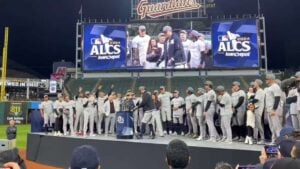







My husband who had been diagnosed with Lou Gehrig’s disease for 2 years at the age of 63 had all his symptoms reversed with Ayurveda medicine from natural herbs centre . com after undergoing their ALS/MND natural protocol. God Bless all Lou Gehrig’s disease Caregivers. Stay Strong, take small moments throughout the day to thank yourself, to love your self, and pray to whatever faith, star, spiritual force you believe in and ask for strength. I can personally vouch for these remedy but you would probably need to decide what works best for you
My husband who had been diagnosed with Lou Gehrig’s disease for 2 years at the age of 63 had all his symptoms reversed with Ayurveda medicine from naturalherbscentre after undergoing their ALS/MND natural protocol. God Bless all Lou Gehrig’s disease Caregivers. Stay Strong, take small moments throughout the day to thank yourself, to love your self, and pray to whatever faith, star, spiritual force you believe in and ask for strength. I can personally vouch for these remedy but you would probably need to decide what works best for you